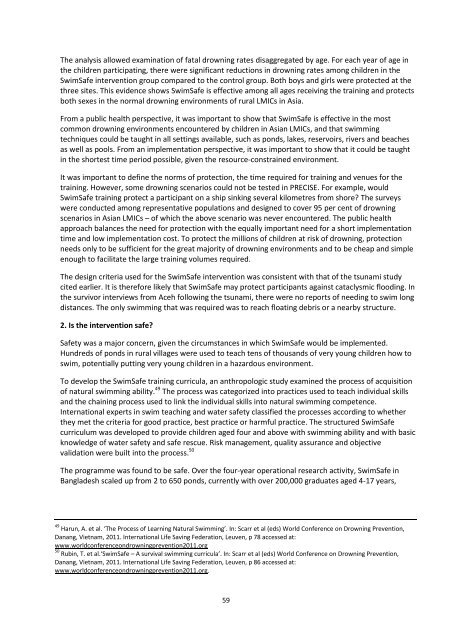Child Drowning
Child Drowning
Child Drowning
Create successful ePaper yourself
Turn your PDF publications into a flip-book with our unique Google optimized e-Paper software.
The analysis allowed examination of fatal drowning rates disaggregated by age. For each year of age in<br />
the children participating, there were significant reductions in drowning rates among children in the<br />
SwimSafe intervention group compared to the control group. Both boys and girls were protected at the<br />
three sites. This evidence shows SwimSafe is effective among all ages receiving the training and protects<br />
both sexes in the normal drowning environments of rural LMICs in Asia.<br />
From a public health perspective, it was important to show that SwimSafe is effective in the most<br />
common drowning environments encountered by children in Asian LMICs, and that swimming<br />
techniques could be taught in all settings available, such as ponds, lakes, reservoirs, rivers and beaches<br />
as well as pools. From an implementation perspective, it was important to show that it could be taught<br />
in the shortest time period possible, given the resource-constrained environment.<br />
It was important to define the norms of protection, the time required for training and venues for the<br />
training. However, some drowning scenarios could not be tested in PRECISE. For example, would<br />
SwimSafe training protect a participant on a ship sinking several kilometres from shore? The surveys<br />
were conducted among representative populations and designed to cover 95 per cent of drowning<br />
scenarios in Asian LMICs – of which the above scenario was never encountered. The public health<br />
approach balances the need for protection with the equally important need for a short implementation<br />
time and low implementation cost. To protect the millions of children at risk of drowning, protection<br />
needs only to be sufficient for the great majority of drowning environments and to be cheap and simple<br />
enough to facilitate the large training volumes required.<br />
The design criteria used for the SwimSafe intervention was consistent with that of the tsunami study<br />
cited earlier. It is therefore likely that SwimSafe may protect participants against cataclysmic flooding. In<br />
the survivor interviews from Aceh following the tsunami, there were no reports of needing to swim long<br />
distances. The only swimming that was required was to reach floating debris or a nearby structure.<br />
2. Is the intervention safe?<br />
Safety was a major concern, given the circumstances in which SwimSafe would be implemented.<br />
Hundreds of ponds in rural villages were used to teach tens of thousands of very young children how to<br />
swim, potentially putting very young children in a hazardous environment.<br />
To develop the SwimSafe training curricula, an anthropologic study examined the process of acquisition<br />
of natural swimming ability. 49 The process was categorized into practices used to teach individual skills<br />
and the chaining process used to link the individual skills into natural swimming competence.<br />
International experts in swim teaching and water safety classified the processes according to whether<br />
they met the criteria for good practice, best practice or harmful practice. The structured SwimSafe<br />
curriculum was developed to provide children aged four and above with swimming ability and with basic<br />
knowledge of water safety and safe rescue. Risk management, quality assurance and objective<br />
validation were built into the process. 50<br />
The programme was found to be safe. Over the four-year operational research activity, SwimSafe in<br />
Bangladesh scaled up from 2 to 650 ponds, currently with over 200,000 graduates aged 4-17 years,<br />
49 Harun, A. et al. ‘The Process of Learning Natural Swimming’. In: Scarr et al (eds) World Conference on <strong>Drowning</strong> Prevention,<br />
Danang, Vietnam, 2011. International Life Saving Federation, Leuven, p 78 accessed at:<br />
www.worldconferenceondrowningprevention2011.org<br />
50 Rubin, T. et al.‘SwimSafe – A survival swimming curricula’. In: Scarr et al (eds) World Conference on <strong>Drowning</strong> Prevention,<br />
Danang, Vietnam, 2011. International Life Saving Federation, Leuven, p 86 accessed at:<br />
www.worldconferenceondrowningprevention2011.org.<br />
59

















